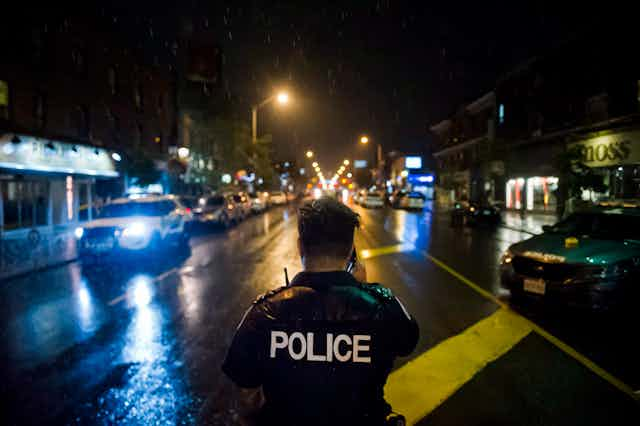In the minutes and hours that followed of the recent mass shooting in Toronto, an all-too-familiar pattern kicked into high gear on social media platforms.
As the events were still unfolding on the streets of the city’s Danforth neighbourhood, the initial sparse facts about the attack were immediately drowned out by a torrent of unverified rumours, unsubstantiated claims and wild speculation about both the identity and the motive of the attacker.
The response on social media abruptly confirmed two tendencies of the digital age: Speed eclipses accuracy and social media abhors an informational vacuum. These tendencies have become unfortunate truisms, played out in the aftermath of similar acts of mass violence.
The instantaneous nature of social media platforms — combined with the attention economy fuelling Facebook, Twitter, Instagram and Snapchat — incentivizes attention-grabbing misinformation and inaccurate “scoops.” The inaccuracies virally spread by expanding their reach and influence at a dizzying rate. One can easily witness this attention-driven virality by watching a social media post’s “like” and “retweet” counts exponentially increase in real-time.

Public officials and law enforcement displayed a justified restraint in making definitive pronouncements about the shooting. But this “gap” in information left the proverbial door open for self-styled pseudo-experts, social media influencers and random agitators to fill the vacuum with conjecture, opinions and false claims masquerading as facts.
Information pollution
It may be easy to dismiss this social media “noise” as the province of fools and naifs and as a small gullible minority taken in by the usual rogue gallery of conspiracy peddlers and Islamophobic hate merchants. But the noise they make is significant as they spread bad information, making it difficult to determine fact from falsehood causing public confusion.
Even more disconcerting is that professional journalists and columnists, employed by reputable media organizations, participated in this avalanche of misinformation on the shooting. For example, one journalist made a quick assumption public when he posted a speculative tweet about the shooter and one columnist claimed that the Canadian media was covering up the fact that the attack was a “Muslim hate crime.”
Social media corporations continue to wash their hands of the problem, prioritizing user engagement and market share over the accuracy of information on their platforms.
Facebook’s recent half-hearted and belated acknowledgement of the scourge of fake news has more to do with assuaging government regulators and public relations spin than with genuinely tackling the problem.
What is clear is that we live in a social environment characterized by severe information pollution, in which the well is poisoned for everyone.
In a setting in which — to paraphrase Gresham’s monetary law — bad information drives out good, what are we to do?
Caution is golden
Our initial and overriding response must be to exercise a healthy dose of skepticism even while witnessing an incident of mass violence unfolding live on our social media feeds.
Caution is golden. More often than not, the first unconfirmed bits of information circulating about an incident like the tragic shooting on Toronto’s Danforth Avenue are usually found to have been erroneous or only partially accurate.
We should not treat on-the-spot, gratuitously formulated conjecture unburdened by the need to respect facts as serious analysis. Rather we should look at these missives as irresponsible fan fiction at best, or bigoted and ideologically driven agitprop at worst.

Without a shred of evidence and fuelled by pre-existing agendas and biased assumptions, many social media insta-pundits and click-starved members of the media are more than willing to jump to conclusions.
They do so by establishing tenuous or non-existent causal links between an attack such as that in Toronto and specific ethno-racial or religious communities, or yet, again, an alarmist narrative about the supposed crisis or decline of Western civilization.
We can achieve factual advocacy in three ways.
The stakes are high. This sort of social media content is not only promoting misinformation, but is often designed to foster and incite fear and mistrust of others, further stigmatizing already marginalized and racialized groups. These groups often bear the brunt of the comment and real-world backlash following a violent tragedy.
The kind of caution and skepticism I call for goes beyond digital literacy. I believe we need to go further.
Citizens are not mere passive readers or consumers of social media. We must see ourselves as factual advocates. We can achieve factual advocacy in three ways.

Most easily, we can starve those who seek to exploit or game the attention economy by refusing to spread their posts and thereby throttling the number of clicks, hits and views their content registers on metricized platforms.
Secondly, we can hold social media personalities and ordinary users accountable to norms of truthfulness and credible evidence. We must treat their unverified tweets and posts as what they are: information pollution.
Finally, factual advocacy demands that those in positions of authority — whether as professional journalists, academic experts or public officials — intervene in the public sphere to denounce rumours and speculation to discredit groups and rebuff individuals fomenting them.
As citizens, we are called upon to become participants in, and contributors to, public debate on social media platforms. We need to ensure that accuracy tempers speed and that the momentary void created in the aftermath of the mass shooting in Toronto and other incidents of mass violence not be polluted by those playing fast and loose with the facts.
While immersed in social media platforms, we cannot stand on the sidelines of informational struggles. Equipped with our apps and a commitment to truth, we must plunge into the social media trenches.

